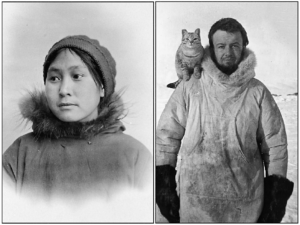
Exploration
Canadian Space Agency astronaut profiles
The men and women that have become part of Canada’s space team
- 1067 words
- 5 minutes
This article is over 5 years old and may contain outdated information.
Exploration

A husband-and-wife team of Canadian explorers will today set off from Ottawa on a first-of-its-kind expedition that will see them circumnavigate the globe using what they call “non-traditional human-powered” methods.
Peter and Pamela Bracefait say they expect it will take them about five years to complete Mission: BRF! (for Bounce, Roll, Fire!), which will see them traverse three oceans, vast expanses of inhospitable desert and several major mountain ranges using only a pogo stick, a human-sized hamster wheel and a wind-up circus cannon.
The wealthy couple, who made their fortune in merchant banking in the early 1990s, have consistently dismissed criticism from within the exploration community that their expedition is nothing more than a stunt designed to attract media attention and catapult them to reality-TV stardom. Though they acknowledge that they’re widely considered to be eccentrics, they also insist that the three modes of travel were chosen after exhaustive research and testing.
“Look, Pamela and I have been through hell and back to make sure that this will work,” said Peter Bracefait during an exclusive interview with Canadian Geographic at his downtown Ottawa home on Saturday. “And we’re ready to go through it all again because that’s what it takes to be groundbreaking, even though the admittedly unusual nature of our gear hasn’t helped build public or institutional support for our expedition. Does it hurt that people think crossing the Alps by circus cannon is impossible? Yes, it does — but that’s not going to stop us from trying.”
The Bracefaits estimate that they’ve spent between $4 million and $5 million of their own money to build their own equipment, which they showed to Canadian Geographic on Saturday. “Everything is built as a tandem device,” said Pamela Bracefait during a tour of the vast basement workshop where craftsmen from Japan, Italy and Chile designed, tested and perfected the gear. “The pogo stick, the hamster wheel and the circus cannon can all be used by two people at once. Peter and I are in this together, after all.”
The Bracefaits bristled at the oft-repeated suggestion that the equipment didn’t seem ideal for crossing water or land. “Nonsense,” said Peter Bracefait. “We’ve rigged the hamster wheel to be lightweight and buoyant, the pogo stick contains a revolutionary spring device good for two billion bounces on all types of terrain — except sand, of course — and the circus cannon is a marvel of precision engineering that can propel you 500 metres. What do you mean, ‘How do you get it back after you’re both fired out of it?’”
Are you passionate about Canadian geography?
You can support Canadian Geographic in 3 ways:

Exploration
The men and women that have become part of Canada’s space team

Exploration
The significant CSA events since Alouette’s launch

People & Culture
This year’s roster of Gold Medal recipients at The Royal…

History
A century ago, a strange drama played out on Wrangel Island in the Russian Arctic. The hero of this tale? A 23-year-old Inuit woman named Ada Blackjack